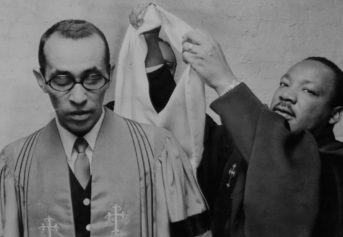
Norman Rockwell’s 1964 painting depicts 6-year-old Ruby Bridges on the day she “integrated” New Orleans’ public schools.
Earlier this week, the Baltimore Sun’s Liz Bowie detailed a $54-million school designed by Johns Hopkins University to model “racial diversity” in education. To erect the facility, Bowie explains that Johns Hopkins University, government and nonprofit partners “bought out hundreds of families, moved 1,000 people and bulldozed scores of deteriorating “row houses” in the predominantly Black Maryland city.
Rucker C. Johnson’s 2011 educational assessment suggests these are justified sacrifices. “For Blacks,” writes Johnson, “school desegregation significantly increased both educational and occupational attainments, college quality and adult earnings, reduced the probability of incarceration and improved adult health status.”
The prevailing consensus is that most Black children are denied opportunities to nourish their brilliance if they are not in integrated schools. ProPublica reports that in 2014, Catherine Lhamon, former assistant secretary for civil rights at the U.S. Department of Education, conceded that there are high-level courses essential to becoming a productive, 21st-century citizen, “but, we are reserving them for a class of kids who are white.”
For more than 60 years, the advertised solution to apartheid academics is to place Black and white pupils in the same school. The pursuit of diverse classrooms accepts that entirely Black schools are inherently and irreversibly defective. This denies a record of exemplary accomplishment in exclusively Black classrooms and commonly diminishes the historic and ongoing sabotage of Black academic institutions.
David Margolick authored a 2011 book on Elizabeth Eckford, a member of Arkansas’ celebrated Little Rock 9. In 1957, Eckford and eight other children required protection from the armed National Guard to become the first Black students to integrate at Little Rock Central High School. Before detailing the racial terror Eckford sustained from her white classmates, he depicts the “underfunded” Black schools she attended before Central. “The schools provided a refuge from the racism outside,” and, according to Margolick, “had a proud tradition, teaching Black pride before the term existed and Black history before there were any texts.”
The traditions of exclusively Black schools drove Dr. Vanessa Siddle-Walker to write “Their Highest Potential: An African American School Community in the Segregated South.” Despite suffocating racism and extraordinary deprivations, Siddle-Walker emphasizes the “institutional policies and community support that helped Black children learn in spite of the neglect their schools received.”
The 1954 Brown v. Board of Education Supreme Court ruling, which declared separate schools for Black children inherently inferior and unconstitutional, is lionized as a conquest over bigotry. Siddle-Walker spotlights “long-overlooked stories of [Black] parents, students and teachers who wanted to maintain their schools when court-ordered desegregation was implemented.” A substantial population of Black citizens rejected the conviction that a desk next to a white student was the only way to achieve educational excellence for Black children.
Drs. Kenneth and Mamie Clark, landmark Black psychologists, gave expert testimony during the ’54 SCOTUS ruling, describing how segregated, financially starved schools “reinforce the inferior status” of Black children. “Their Highest Potential” reveals dissenting Black North Carolinians who “refused to send their children to school for an entire year in protest of a desegregation plan that would have unnecessarily closed two Black high schools.” For decades, while Black children were denied entry to white schools, Black educators were cherished for cultivating the next generation of Race Women and Race Men. Some educators, scholars and Black parents have rejected enrollment in “racially diverse” schools along with the notion of innately substandard Black classrooms.
Describing, “the story of the education of African-American children,” Siddle-Walker documents how “Blacks were continuously denied adequate funding and consistently had poor facilities and materials compared to those of their white counterparts.” For decades, whites across the United States methodically undermined Black educators and stifled the academic growth of Black children.
A number of Black instructors charge that this policy continues. In 2015, NPR’s Gene Demby reported on the fiscal hurdles at South Carolina State University, a historically Black college, which prompted some state lawmakers to propose closing the school. A collection of HBCU presidents charged that Black institutions were not receiving their full allotment of state funding. An investigation substantiated their suspicions, as Black land grant colleges in 17 states “had been shortchanged by a total of $56 million in state funding, while several predominantly white land grant colleges had gotten more than they were owed.”
Demby also cited a 2013 federal ruling that acknowledged Black colleges were subjected to “persistent underfunding” reminiscent of the Black Little Rock schools that Elizabeth Eckford left behind to pursue “diversity.”
Perhaps more important than the financial undermining is the racist belief that education is terribly wasted on Black children. Nikole Hannah-Jones, an award-winning journalist who writes often on racial injustice in education, sees a “vast disparity in resources and expectations for Black children in America’s stubbornly segregated educational system.” Chillingly, racists have successfully miseducated a number of Black people to believe that Black teachers, Black schools and Black people are hopelessly inadequate. With this thinking, it’s not surprising that the only source of salvation is to diversify schools.
Which is why Bowie’s prospects for the academic future of Black Baltimore conclude with “a young white couple moving to the area from California.” Only an infusion of white California girls and boys makes the improvement of education for Black children possible.
Gus T. Renegade hosts “The Context of White Supremacy” radio program, a platform designed to dissect and counter racism. For nearly a decade, he has interviewed and studied authors, filmmakers and scholars from around the globe.


